




The vast majority of pesticides used in the amenity sector are herbicides. Of those the majority are based on the active substance glyphosate which accounts for approximately 77% of all herbicide use in the sector.1 For that reason this briefing will focus specifically on alternatives to herbicide use in controlling weeds and other vegetation in the amenity setting.
The information provided here is not only relevant to councils but to any land managers with responsibility for weed control. Areas such as golf courses, railways, motorways and universities, to name but a few, are all major users of herbicides and, in response to growing public demand, will be seeking alternative controls in order to reduce or end their herbicide use.
It is undeniable that herbicides such as glyphosate are effective tools for dealing with unwanted vegetation in the amenity sector. However, in recent years, a growing body of evidence has pointed to the hazardous properties of glyphosate and other herbicides, the risk their use poses to operators and the public as well as wider concerns about the potential for herbicides’ negative effects on biodiversity.2 Adding to the increasing calls for alternative approaches to be found are concerns around possible litigation cases against local authorities over their use of herbicides. A recent US legal case brought against the manufacturers of glyphosate, one of a number of similar cases, resulted in a school groundskeeper being awarded millions of dollars in compensation as a result of contracting nonHodgkin’s lymphoma from using glyphosate-based products in his day job. Such cases highlight the significant financial and legal risks the use of herbicides poses to local authorities and other land managers. With the GMB Union, which represents
council employees, calling for a ban on the use of glyphosate to protect the health of its members and the general public, pesticide operators in the UK amenity sector have become more aware of the potential risk to their health and it could arguably only be a matter of time before such court cases are taken in the UK.
There have also been some moves in EU regulation to try and reduce the use of glyphosate and other herbicides in areas frequented by the general public. For example, the European Commission’s most recent decision to authorise glyphosate in 2017 established three conditions for use of the herbicide including “Minimise the use in public spaces, such as parks, public playgrounds and gardens”3
Similarly, the 2009 European Sustainable Use Directive states;
Member States shall, having due regard for the necessary hygiene and public health requirements and biodiversity, or the results of relevant risk assessments, ensure that the use of pesticides is minimised or prohibited in certain specific areas. Appropriate risk management measures shall be taken and the use of lowrisk plant protection products as defined in Regulation (EC) No 1107/2009 and biological control measures shall be considered in the first place. The specific areas in question are: (a) areas used by the general public or by vulnerable groups as defined in Article 3 of Regulation (EC) No 1107/2009, such as public parks and gardens, sports and recreation grounds, school grounds and children’s playgrounds and in the close vicinity of healthcare facilities;4
1 Fera, Amenity Pesticide Use Survey 2016, April 2018, https://www.gov.uk/government/statistics/pesticide-usage-survey-amenity-pesticides-in-the-uk-2016
2 PAN International, The Glyphosate Monograph: The Glyphosate Monograph: A comprehensive new review of the science documenting the adverse human health and environmental impacts of glyphosate and glyphosate based herbicides, October 2016, https://issuu.com/pan-uk/docs/glyphosate_monograph_ complete?e=28041656/43997864
3 European Commission website, earlier assessment of glyphosate, https://ec.europa.eu/food/plant/pesticides/glyphosate/earlier-assessment_en
4 European Directive on the Sustainable Use of Pesticides (SUD) 2009/128/EC, https://eur-lex.europa.eu/legal-content/EN/TXT/?uri=CELEX%3A32009L0128

Councils in the UK are heeding those calls and are beginning to look for effective alternatives to control unwanted vegetation in their parks and green spaces and along roads and pavements. Whilst a number of councils have already made commitments to adopt non-chemical control methods they are still in the minority. For many, the thought of switching away from the ‘traditional’ use of herbicides is a daunting prospect. In many cases the availability of effective alternatives remains an unknown factor and, even when known about, concerns about the cost, effectiveness and availability remain a hindrance to adopting a pesticide-free approach. Councils are not alone as public pressure is also being focussed on other land managers throughout the UK. Again, some are already making progress in adopting alternatives while the majority lag behind.
In this briefing we will showcase the alternatives that are currently available and demonstrate that adopting such approaches can assist considerably in switching away from the habitual use of herbicides, or at the very least dramatically reducing their use.
Several other countries have already taken action to stop and reduce the use of herbicides, most notably in France where a ban on the use and sale of non-agricultural pesticides has been in place since January 2019. Both Germany and Austria have announced intentions to end the use of glyphosate in the next few years. Many European rail companies are also investigating the use of alternatives to glyphosate for track maintenance.
In the UK approximately 80 councils, ranging from parish to district and county level, are taking action to stop or reduce their use of herbicides. Other land managers are also taking a keen interest with water companies and some parts of the transport network investigating and adopting alternative approaches.
There are many and varied benefits to switching to a non-chemical weed control approach:
6 Environment: reduced pollution (air, ground and water). Herbicide use in urban areas, and more specifically on impermeable surfaces, is a source of water pollution which generates significant costs for water companies and subsequently to the end user.
6 Biodiversity: benefits to pollinating insects and other beneficial insects, soil micro-organisms, birds, amphibians and plant diversity.
6 Citizens: protection for the most vulnerable groups from exposure to potentially harmful substances thus improving the quality of life for residents (and their pets) and those entering the city and its green areas.
6 Staff: will be better protected from the short- and long-term health consequences of occupational exposure to herbicides.
6 Getting ahead of the game: pre-empting any changes in pesticide regulations.
6 Reducing your costs: adoption of pesticidefree techniques has shown cost savings in the long-term where it has been developed over a number of years.
6 Legal and financial liability: reduce or remove the potential for an expensive court case taken by operators or bystanders who develop health problems resulting from exposure to herbicides.
6 As a selling point to the public: the public are keen to see pesticide reductions and reducing or stopping their use can boost the ‘green’ credentials of a council.
When planning to reduce or stop the use of herbicides, the most critical first point is to be aware that there is no silver bullet – there is no like for like replacement. To make a successful transition away from herbicide use, the nonchemical alternatives deployed have to comprise of a mixture of techniques and approaches backed up by a sensible, achievable strategy and the political will to see the plan through over the long-term. With these key points in mind this briefing will look at some of the main alternatives to herbicides for controlling unwanted vegetation.

The biggest elephant in the room when looking into alternatives to herbicides is that of cost. Given the often parlous state of local authority finance any potential increase in costs could present a serious obstacle to adopting a pesticide-free approach. However, there are a range of creative ways for councils to keep costs down and the good news is that costs don’t necessarily have to rise.
The example of Hackney Council (see the case study on page 12) which has simply reduced spraying shows that actually significant savings can be made both in terms of cost and volume of herbicide used without incurring other problems. By auditing their herbicide use to identify where they didn’t need to spray and switching to spot spraying, Hackney Council reduced its herbicide use by 40% overnight and made a saving of £10,000 per year.
In other UK councils, where they have chosen to adopt high-tech non-chemical alternatives, relatively small increases in costs have been reported, largely the result of having to purchase new equipment. However the experience from these councils has shown that, after the initial capital outlay, ongoing costs have reduced considerably. This is backed up by cities in Europe which have been pesticide-free for decades and have shown that, after an initial small increase, over the longer term costs will come down.
Even though the cost increases are relatively minor, given the state of council budgets there is without a doubt a need for local authorities to look at approaches that will keep costs down. Options for councils looking to buy equipment to administer non-chemical alternatives include: sharing the initial cost of the machine with one or more adjacent council; getting a local company to ‘sponsor’ the machine by covering the cost of purchase; hiring the equipment out to neighbouring councils or local land managers; and getting the council’s contractor to buy the machine. These options are made possible by the fact that, unlike glyphosate, many of the new non-chemical approaches such as hot foam systems can be used in all weather conditions. Councils don’t tend to need more than fifty days per year of use so the machine is available to be hired out to, or shared with, others the remainder of the time. For more suggestions on dealing with the potential cost of going pesticide-free see page 11 of the PAN UK Going Pesticide-Free: A Guide for Local Authorities - https://issuu.com/pan-uk/docs/ pft_a_toolkit_for_local_authorities?e=28041656/43992989
Cost does not have to be an insurmountable problem. It is also worth noting that in the UK we are still very much at the start of the pesticide-free journey. Improvements and saving will be developed over time and costs will eventually reduce as they have in other sectors such as alternative energy.
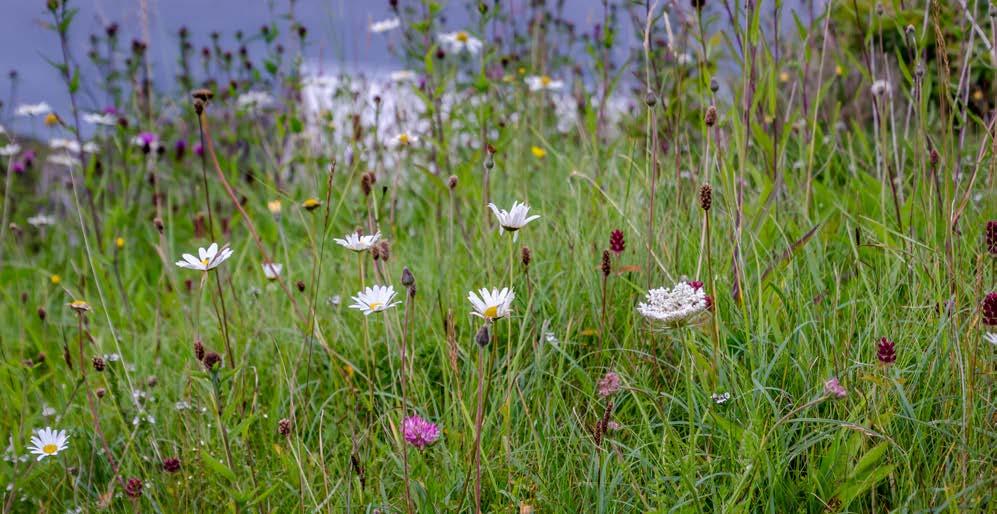

Not using anything to replace the use of herbicides costs nothing – in fact it saves money which can be used to support other activities. This might seem like quite a radical approach, and of course if nothing at all was done to control all unwanted vegetation then there would be problems. But doing nothing is not really doing nothing! In reality, it’s looking strategically at where vegetation can be left alone or where expectations can be adjusted for those both maintaining and using public spaces.
The first thing to do when looking to adopt an herbicide-free approach is to undertake an audit of which areas are currently being treated, why and how often. This involves asking a number of questions;
6 Is there actually a need to spray in this area?
Looking at whether a particular area could be managed in a different way in order to avoid having to treat it with herbicides is an important tool in any herbicide use reduction strategy.
Areas left to grow wild for insects - The Level in Brighton
Questions to ask include, could you change the kind of plants you maintain in a park from the traditional bedding plants that need managing to one that uses wild native species that would naturally out-compete weeds? Could an area of amenity grass that might be sprayed to keep it looking neat and tidy be converted to a wildflower meadow?
Supporting urban biodiversity and stopping or reducing the use of herbicides is a win-win for all concerned. And the increasing public understanding regarding the need to protect our bees, pollinators and other insects means that this type of approach will be widely welcomed.
““ No alternative is the cheapest alternative ”
Hackney Councillor John Burke in response to comments that ending glyphosate use would hugely increase costs
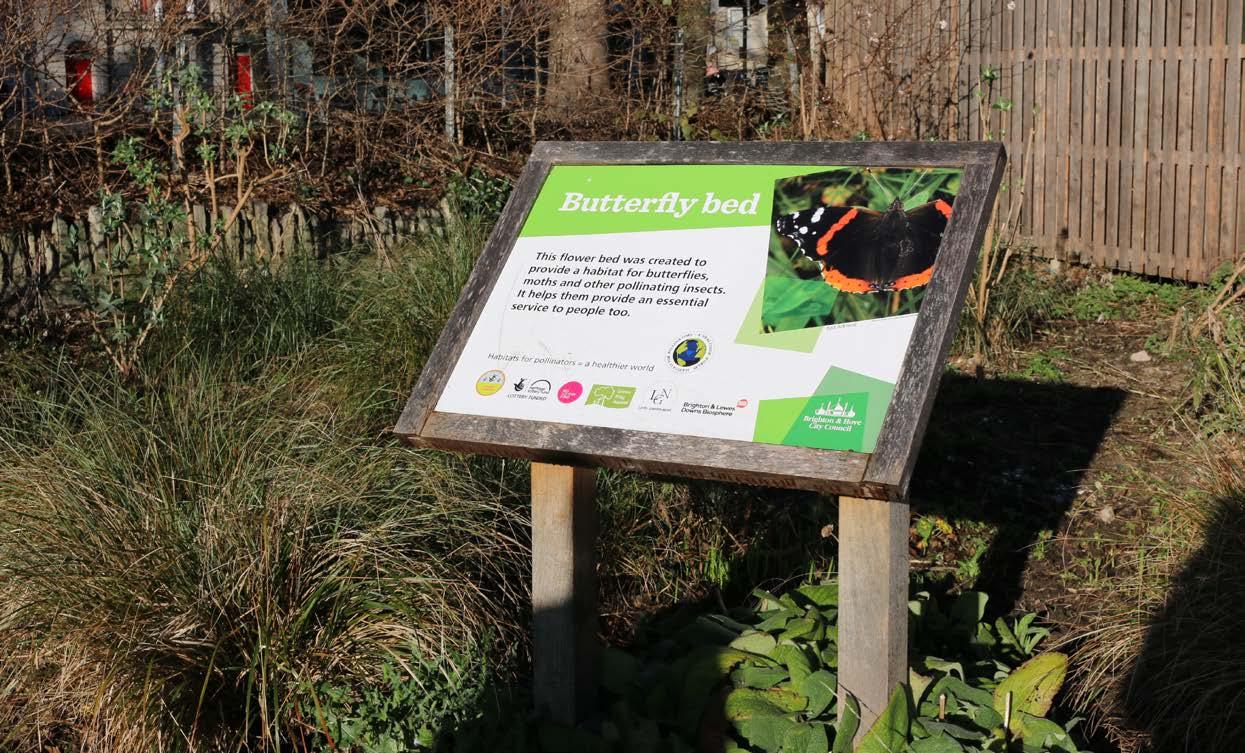

Communicating clearly what you are doing and the benefits to both health and biodiversity is an effective, simple and cheap way to gain maximum support for the work you are doing.
It is also essential to explain to the public that their surroundings will start to look different as the use of herbicides is phased out - there will be an increase in ‘weediness’. Given that complaints about weeds are one of the most commonly received communications by councils it is vital to explain that this ‘weediness’ comes with increased benefits for local biodiversity and the health of operators and the public, as well as potentially saving the council money. The public needs to be on your side and is much more likely to be if they understand what you’re doing and why.
6 Could this area be controlled in a different way?
We are seeing an ever-growing number of reports showing alarming declines in insect abundance and biodiversity losses in general. Towns and cities can become wildlife havens and help support and encourage biodiversity. One recent trend has been to reduce, or even stop, the spraying of roadside verges and similar areas, at least in the spring if not completely. Evidence shows that adopting such an approach can create important habitats for bees and other pollinator species as well as allowing wild plant species, such as orchids, to re-establish and thrive. Another effective approach has been to mow green spaces such as verges instead of spraying herbicides. However, land managers should ask themselves if mowing is necessary and how often because, similar to reducing herbicide use, decreasing mowing or ending it all together can also benefit biodiversity.
Land managers should ask themselves the following questions: could the frequency of spraying be reduced or stopped? Have you assessed whether an established twice a year spray regime could actually be reduced to once a year? Are the areas being treated really in need of treatment or could they be left until later in the growing season in order to reduce to one spray? Just by taking this relatively simple (and cost-saving) action, land managers can halve herbicide use.
People have been dealing with weeds for many years, long before herbicides became the accepted method of removal. So perhaps looking at some of the old established techniques is a useful way forward, depending on the type of space that is being managed.
Perhaps the most ‘old fashioned’ way is simple hand-weeding, actually going in and physically removing weeds by hand. Whilst this is not a technique that can be applied easily to road and highway maintenance it can be effectively employed in parks and green spaces or other smaller areas.
It is worth pointing out that it doesn’t necessarily have to be done by hand - the use of hoes, rakes and weeding hooks can all be employed to make the task easier. This is particularly effective for weeding cracks between paving and along the edges where pavements meet walls.
Hand weeding can be done by volunteers, particularly in parks and green spaces but this could also be adopted on housing estates and similar areas with great effect. Making use of Friends of Parks groups by holding weeding days in parks is a great way of getting people together and also getting the work done. In some areas, such as Tower Hamlets Cemetery Park in London, they invite groups from companies in for team-building days to weed and also get to know their local green spaces better. So not only can weeding be accomplished without the use of herbicides but social inclusivity can be enhanced by using volunteer teams. In fact, this has been a steadily growing phenomenon with teams of concerned local volunteers going out and weeding their localities as an alternative to herbicide use. From Edinburgh to Brighton, local people are mobilising to make the spaces where they live safer for all.

One area that could really profit from hand weeding is in schools. Children are particularly vulnerable to the effects of pesticides and so there is an urgent need to end the use of herbicides in schools. Combining hand weeding with lessons on biology, botany or food growing could be a great way to get the job done and bring children closer to nature.
Even without the use of volunteers hand weeding is a viable option for smaller areas. It simply takes a bit of training to identify weeds in the first place, and then a mind-set that requires staff to pluck weeds out as they see them rather than leave them until the regular spraying is scheduled.
More mechanised methods are also acceptable alternatives to herbicides. Mowing and strimming regularly where required will keep weeds at bay, although it is important to monitor growth and undertake regular work. The good news is that areas are already likely to be mowed or strimmed as part of general site maintenance so this approach should not incur any extra costs.
Mulching is a widely-known and accepted method for keeping weeds at bay. It reduces weed growth by keeping light from reaching the soil surface and involves using natural materials such as tree bark and wood chips or one of a variety of mulch mats that are available from various retailers. It is also possible to use other materials such as sand. This approach was deployed successfully in the Olympic Park in Stratford to deal with weeds in the newly planted flower areas. Sand can also be used beneath newly laid paving to deter weeds.
A more aesthetically pleasing approach is to use vegetation traditionally labelled as ‘weeds’ as display plants. Many of these so called ‘weeds’ will be native species, ideally suited to local conditions, and bring benefits for bees and other pollinators. In addition, these plants will often produce beautiful displays of flower and foliage that are able to compete aesthetically with more traditionally accepted ornamental plant varieties.


Many councils and other land managers will spend thousands of pounds each year on annual bedding plants because this is what they have always done and it is what the public have come to expect from flower beds in parks. By using perennials and ornamental grasses that do not need replacing every year an equally vibrant display can be achieved, thereby eliminating the costs of replacing bedding plants annually. It is a matter of changing the expectations of the visiting public. This task is becoming easier due to growing public support for native plants and wildflower meadows, both in terms of their biodiversity benefits but also their aesthetics.
In summary, a mixture of mechanical weed removal methods, more strategic plant choices and changes to public expectations can all help in moving away from the use of herbicides.
Better design of urban areas could reduce or remove the need to use herbicides altogether. This is an approach that has been used in several European countries with success. The basic premise is to use membranes beneath paved areas to stop weed growth, eliminate cracks where weeds and seeds can accumulate and ensure that areas are easily accessible for brushing to remove weed build up. Of course this is difficult to achieve unless an area is being redesigned or built for the first time but as an option for the future it is worth considering. Designing out the need for pesticides can also include some of the things mentioned in the ‘do nothing’ section of this report. Leaving space for wildlife, creating meadows and allowing verges to grow are all part of the urban rewilding approach that can help reduce the use of herbicides.
For roads, pavements and larger areas, hand weeding and other low tech solutions are often not a viable option. There has been a huge surge in the development of high-tech alternatives to herbicides for the amenity sector over recent years, as well as the continuation of some tried and tested approaches that have seen success with land managers, particularly in Europe. It is to be hoped and assumed that, as the demand for non-herbicide weed control methods increases, the alternatives outlined below will be refined and added to. Consequently, costs, which are always a concern, will start to decrease across the board.
6 Thermal control with hot water or foam Plants do not like an excess of heat – it kills them! With that basic principle in mind, a range of technologies have been developed which use heat to replace herbicides. It was not uncommon in years past for people to throw a kettle of boiling water over an unwanted plant and the following methods are really just more effective versions of that approach.
There are a number of different approaches –steam, hot water and hot water with foam added. All of them work on the principle that temperatures near to boiling will kill the cells in the parts of the plant that are above ground surface. The plant itself is ‘cooked’ and dies. However, the root is not immediately killed as it would be with herbicide application, but with repeated treatments the plant will eventually weaken and die down to its roots.
This is one of the reasons why there has been some reluctance in taking up this technology following a single demonstration. It isn’t in the first instance as effective as an herbicide but, given time, it will be equally if not more effective. This is why it is vital to undertake a proper trial of alternatives rather than simply rely on a one-off demonstration. For more information on How to run trials of non-chemical alternatives see page 16 of the PAN UK Going Pesticide-Free: A Guide for Local Authoritieshttps://issuu com/pan-uk/docs/pft_a_toolkit_ for_local_authorities?e=28041656/43992989

It seems that steam weeders have rather fallen out of use for anything other than homes and gardens, at least in the UK, but there are two remaining systems that employ the thermal properties of hot water to treat weeds.
i. The hot water system, supplied by Oeliatec (oeliatec co uk/) works with just hot water. The water is heated to around 120 Degrees centigrade which is applied with a low pressure system via a long hose. It is very effective at killing weeds and can be used for other purposes such as killing moss and algae.
i. The hot foam system (known as Foamstream and supplied by Weedingtech - www weedingtech com/) is very similar but, in addition to hot water, also uses foam made from vegetable oils to hold the water at a high temperature for longer. This makes it more effective at killing the plant as it is ‘cooked’ for longer. As with hot water, the system can also be used to kill moss and algae and remove chewing gum and graffiti. The foam itself is made from vegetable oils obtained from a variety of sources including wheat, maize and olive oil.
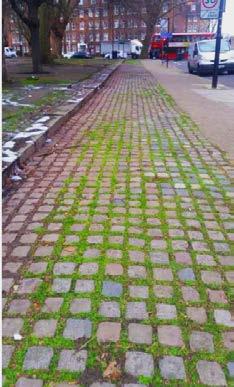
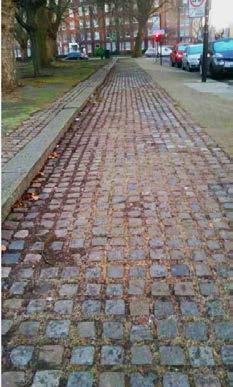
Both of these systems use non-toxic materials to achieve their results which means that neither has to be licensed under any of the existing pesticide regulations in the UK – including requirements for operator training and certification.
In addition, because the materials are inert they can be used in situations where herbicides cannot such as next to water courses or in rain
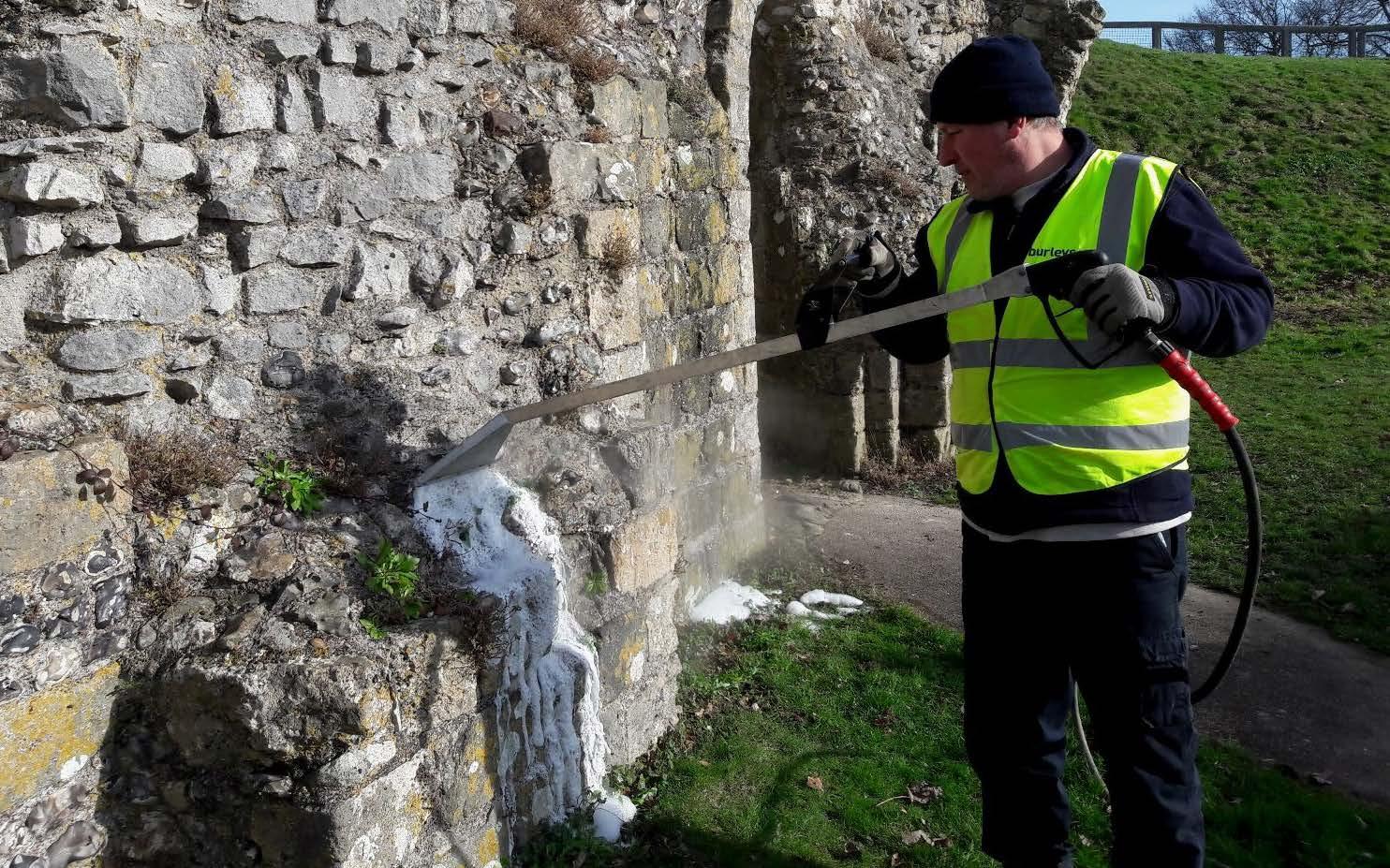

and wind – all too frequent weather conditions in the UK. So these systems are as effective as herbicides but far more versatile in terms of when and where they can be used because they pose no identifiable risk to health or environment
One of the key obstacles preventing councils from adopting hot water or foam systems has been the cost of the machinery. However, increasing numbers of contractors are purchasing machines and offering them to clients. Some UK councils have chosen to include in their contract a requirement that their contractor uses herbicide-free technology. As we see more and more councils and land managers requiring herbicide-free approaches and this becomes the new norm, the costs will start to reduce as competition between contractors grows.
We have also seen some novel approaches to spreading the burden of the initial cost of machinery. Glastonbury Town Council purchased a Foamstream machine and have been hiring it out to other land managers in order to recoup some of their initial capital outlay.
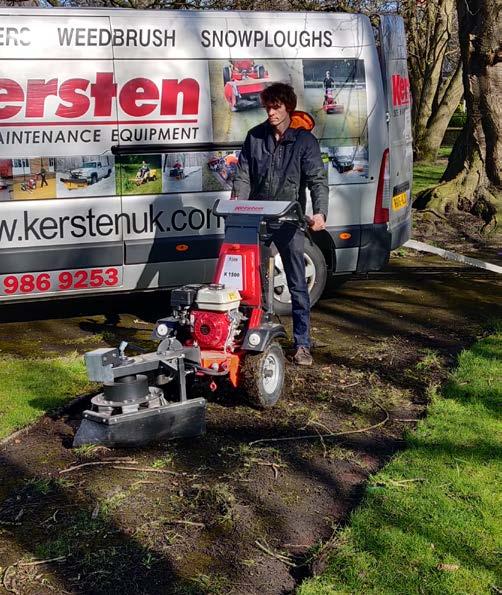
PAN UK has also been encouraging adjacent councils to share the costs of the machinery between them. There is scope for this as the system can be used at any time, it doesn’t need to be a dry wind-free day, and so a council can book in its weed maintenance schedule months in advance. Councils don’t tend to need more than fifty days per year of use so the machine is available to be hired out to, or shared with, others the remainder of the time, enabling the sharing of equipment across council borders.
Brushing can be a very effective way to control weeds on pavements, block paving and other hard surfaces. Wire brushes are spun at high speed over the surface of the ground to rip weeds out of the ground. There are many versions of such technologies available and one of the main suppliers in the UK, Kersten (www kersten-machines com/moss-weedremoval htm), supplies a range of different sizes to suit varying applications.
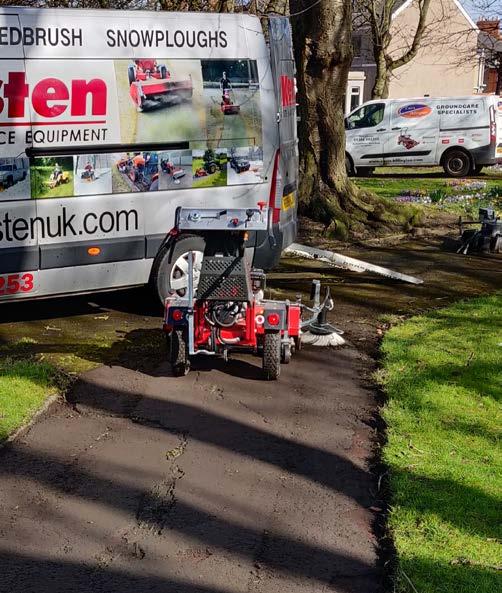

One of the major benefits of brushing is that it not only clears the weed itself but also other detritus, discouraging future growth. In contrast to herbicides or thermal technologies, the plant material is also removed by the brushing action so there are no remaining plant materials to collect. It can also be described as a preventative approach because regular brushing will ensure that areas are kept free of detritus, including rubbish and soil, which can provide fertile breeding grounds for unwanted vegetation if left unchecked.
Brushing is also a very versatile approach that can be used on a variety of different surface types including gravel, artificial grass, block paving, tarmac and concrete. The main drawback is the potential for damaging the surface that is being treated. However, developments in brushes for specific use on different surfaces mean that the likelihood of damage has been greatly reduced.
Flame weeding was once a very popular option, particularly in Europe, but due to a variety of concerns about health and safety and carbon emissions their use has declined. However,
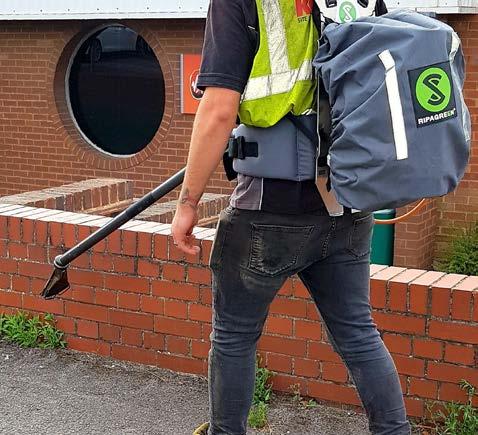
they remain a useful tool for dealing with weeds in hard to reach places where other types of machinery would struggle
A new development in this area of technology is the infra-red weed burner. The system uses a combination of infra-red radiation and hot air to destroy weeds. The hand operated system is particularly suitable for use on paths and paving.
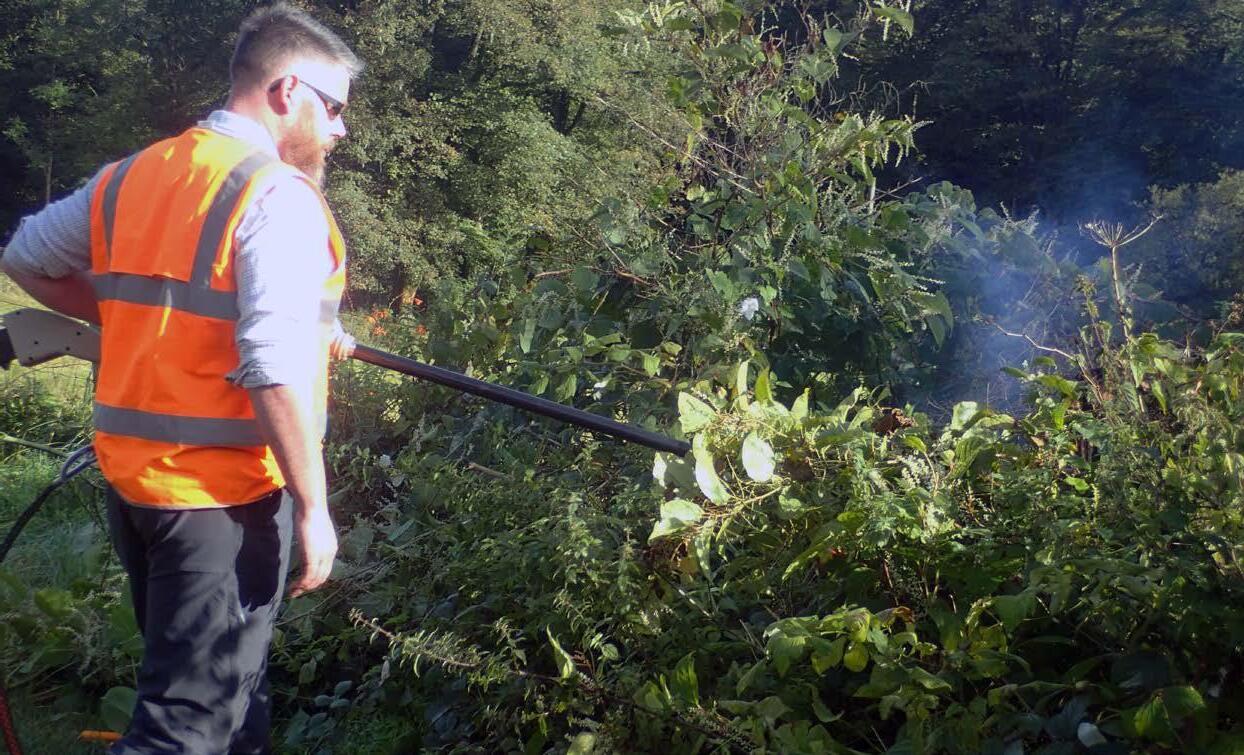

The UK based company Ubiqutek ( www rootwave com ) has been developing a new system based on the use of electricity for weed control. They call their Rootwave system an ‘electricide’. It works by passing a current of electricity through the plant which boils the plant from the root up. It has been shown to be a very effective control system and has been adopted by a number of organisations including the English Heritage organic garden.
However, its use is limited in that only one plant can be treated at a time. This means that for large areas of pavement or road it would be too time consuming to make it a viable option. Where it comes into its own is for smaller spaces, such as gardens and historical sites and in particular for treating invasive species.
For a quick guide to the pros and cons of the different systems please see the comparison table on page 15 13
Alternative approaches can be useful in the control of invasive species such as Giant Hogweed. Credit: David Brierley, Flickr CC BY 2.0
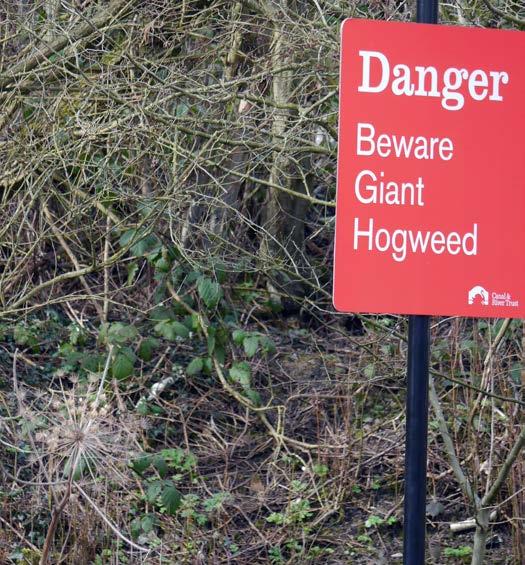
One of the main concerns raised by councils and other land managers when moving away from herbicides is how to effectively control invasive species such as Japanese Knotweed and Giant Hogweed.
The good news is that the methods mentioned in the previous section (hot water and foam, brush and flame weeding and electricity) can also all be used to control invasive species and are proving to be just as effective as chemical methods. In fact, due to the fact that they are less restrictive in terms of when and where they can be used, they might actually prove to be a more useful tool in the control of invasive species than herbicides.
Given its prevalence across the UK, there has been a particular focus on finding non-chemical methods for dealing with Japanese Knotweed. The development of the patented Meshtech system by the UK company Japanese Knotweed Solutions (www jksl com/japanese-knotweedtreatment/meshtech-removal) is an exciting development in the fight against this pernicious invasive species. The system itself uses a fine mesh that is placed on the ground where knotweed is growing. The plant grows up through the mesh but as the tubers swell it cuts itself off. This process is then repeated until the plant is sapped of so much energy that it eventually dies. The process is not an overnight solution since it can take a number of years to completely eradicate the plant. However, it is non-chemical and unobtrusive, can be used in any situation and is ideally suited for use around the aquatic environment.
If there really is no viable alternative, then stem injection should be the preferred approach to using herbicides to control invasive species. The herbicide is injected directly into the stem of Japanese Knotweed or Giant Hogweed and then taken into the system to kill the plant. This is a very effective method of killing plants. However, even though it reduces the volume of herbicide used and makes run-off less likely it still comes with associated risks to human health and environment.

Since the summer of 2018, Hackney Council in London has been looking at ways to stop and reduce the use of glyphosate and other herbicides in areas under its control. As far as PAN UK is aware, the approach taken by Hackney is unique among UK councils that have adopted pesticide reduction strategies in that they are not looking for a replacement for herbicides but are instead working to stop use where they can and allow wild plants to flourish.
Between May 2018 and In April 2019 Hackney Council implemented the following actions:
6 Immediately reduced the number of roads sprayed with glyphosate by 20 per cent
6 Changed the way the Council sprays from operatives mounted on vehicles to spotspraying with knapsacks
6 Reduced the number of sprays from four to three per season
6 Stopped spraying more than 100km of pavements on high streets
6 Ended spraying in Hackney’s main pedestrian areas removing weeds by hand instead of chemically.
By adopting these simple measures Hackney has reduced the amount of glyphosate sprayed by 600 litres, a 50% reduction on the amount used in 2017. It has also saved the Council in the region of £10,000 per year. The Council has stated that it will
be possible to reduce spraying even further over the coming year thereby reducing costs further for Hackney residents.
In May 2019 Hackney launched a no-spray pilot area to run for one year to assess the results of simply withdrawing spraying altogether. A final report on the results has been delayed due to Covid-19. However, reports during the year have shown an increase in wild plant diversity and there have been no issues with weeds or negative comments from residents. Moving forward Hackney council has decided that all housing estates under their control will be managed without the use of glyphosate from 2021.
Glastonbury Council decided to undertake a trial of several alternative approaches and compared hand weeding, hot water and the Foamstream system. The trial monitored the time taken to apply the treatments, the effectiveness in terms of immediate weed control and the level of regrowth following treatments.
The trial concluded that hand weeding was not viable due to the high labour costs. Similarly, hot water turned out to be unsuitable due to the cost implications. The Council’s cost analysis (the results of which are in the table below) revealed Foamstream as the best system, even when compared to herbicide use.
Results of Glastonbury Council's cost analysis of weed control options
Hand Weeding by contractor
Hot water treatment by contractor
Glyphosate treatment by contractor
Foamstream factoring in costs of diesel, foam, in-house application, van and water. Excluding initial cost of equipment

Cost per linear metre
£00.32
£00.26
£00.23
£00.07
It is clear that the running costs for Foamstream were significantly lower than the other alternatives, including herbicides. However, the cost of the machine does need to be factored in and Glastonbury Council did have to purchase the Foamstream machine for its own use and then train its staff to operate the equipment. Glastonbury Council is currently looking at the options for hiring the equipment out to other neighbouring parishes in order to recoup some of the initial cost outlay. It also estimates that over the long-term the cost of running the machine will decrease due to greater efficiencies and a reduced treatment area.
In terms of the effectiveness of weed control, the Council has reported that the Foamstream system took a similar length of time to apply as glyphosate but that its effectiveness in terms of killing weeds from a single use was higher. The regrowth following the initial trial was reported to be minimal, but testing over the longer-term is needed to establish the full effectiveness of the system.
However, given the fact that Foamstream can be used in all weather conditions there is a lot more scope for when it can be applied and how effective a treatment it remains. In contrast, glyphosate cannot be used in the rain and its effectiveness is diminished should rain follow application, thus requiring further treatments or leading to a less effective end result.
This shortened article was written by Steve Peters (former garden manager of the Level) and appeared as a blog on the PAN UK website in May 2019 - https://www.pan-uk.org/managing-a-citypark-without-pesticides
The park’s complete restoration using Heritage Lottery, Big Lottery Fund and other funding sources in 2013 provided the catalyst to create and develop this important community and destination park as an environmental and conservation centre of excellence - aiming to provide pollinators and other wildlife with a home in the city.
Every part of the park is its own miniature, unique ecosystem with its own combination of plants, trees, shrubs, soil conditions, insects, microorganisms and microclimate.
An herb rock garden was created to provide habitat for insects due to its diverse planting, such as basil, chives, tarragon, thyme, mint, rosemary, oregano, marjoram, coriander and sage. The rocks also provide a place for insects to hide and for lichens to grow.
A ‘bee bed’ was established in the North West corner of the park, this demonstrates the attractive garden plants that people can grow at home to benefit a variety of pollinators, an initiative with the University of Sussex’s Laboratory of Apiculture and Social Insects (LASI). And in 2016 a butterfly bed was created using a range of plants including globe thistle, cat mint, buddleia and clumps of stinging nettles.
The success of the new planting in these areas helped increase food for pollinators by 20%, due to fact that, some plants have a longer flowering period than others.
How does The Level manage without pesticides? By planting flower beds to capacity, there are less areas for weeds to grow. Also, good soil management results in healthier plants that are more resilient to pests and diseases. No peat-based materials are used (organic material only) such as autumn leaves, grass trimmings, spent coffee grounds; wood ash, and tea leaves. Over 95% of green waste is recycled on site. This in turn provides a home for a number of environmental heroes, including microbes, earthworms, woodlice and fungi.
Designated areas, such as the perimeter of the park, have been left to grow. These habitats also increase the biodiversity of the park. Good plant diversity, such as a wide range of perennials, shrubs and wild flowers, create a healthier ecosystem for pollinating insects, as well as other beneficial insects. Some species of plants, such as stinging nettles, chicory and Achilleas, have beneficial effects on neighbouring plants. Commonly known as Dynamic Accumulators, or ‘mining plants’, they can mine sodium, sulphur, nitrogen, calcium, potassium, iron and copper which improve the neighbouring plants defences against pests and disease.

By using propagated plants and seed from on site, it is better guaranteed that the plants will of good stock and free from any pesticide contamination. Neem oil is used for controlling some pests and diseases, such as greenfly or blackspot. And there are a number of local citizens that volunteer their time each week to helping with some of the more physical aspects of keeping the park running smoothly.
The London Borough of Hammersmith & Fulham banned the use of products containing glyphosate in June 2016. This was a response to both public concern and their ambition to make the borough the greenest in the country. The ban covered the use of glyphosate-based products in all grounds
maintenance operations in the borough, with a derogation for use on invasive species.
Hammersmith & Fulham worked closely with their contractor, Idverde, to trial various alternatives including flame burners, acetic acid and hand weeding before deciding on the Foamstream system. As a result there are now five Foamstream machines used in Hammersmith & Fulham – three for housing sites and two that are used in parks and green spaces.
There were some initial issues that needed ironing out. In particular coordination of operational schedules to make sure that dead plant materials were swept away after treatment with Foamstream. However, this has led to a more joined up way of working which ensures maximum effectiveness and minimum disruption for residents. The system is currently used at 176 of Hammersmith & Fulham’s housing sites and all of its parks and green spaces.
Switching to a pesticide-free regime is not something that can usually be done overnight. In order for it to succeed it needs to be backed up by a clear policy that will help set the direction of travel, drive the whole process and support those that are actually out in the field delivering the new approach.
There are four key elements of a pesticide-free policy that need to be implemented. They can of course be adapted to the specific conditions that pertain to your situation;
i. Undertake an audit of current pesticide/herbicide use across all sectors including, but not limited to, parks and cemeteries, streets, housing and schools.
ii. Initiate a stakeholder forum for land managers from across the town/city/borough. In addition to council representatives, this should include other land managers from (for example) hospitals, schools and universities, retail and shopping areas, housing estates etc.
iii. Develop a communications strategy to inform the public and others about what you are doing, why you are doing it and what you hope to achieve.
iv. Develop a protocol for trialling non-chemical weed control methods in a variety of locations.
The PAN UK three year phase out plan contains greater detail about how to adapt and adopt the above measures and information on where to go once these are in place - https://www.pan-uk.org/ information-for-local-authorities/
For a more in-depth look at how to devise a comprehensive pesticide policy which drives a reduction (and ultimately an end) in herbicide use, see page 14 of the PAN UK Going PesticideFree: A Guide for Local Authorities - https://issuu.com/pan-uk/docs/pft_a_toolkit_for_local_ authorities?e=28041656/43992989

Initial cost
Ongoing cost
Efficacy
Ease of use
High – for the cost of the machinery if purchasing outright
High – for the cost of the machinery if purchasing outright
Medium –depending on the size of the brushing machine
Small amount of initial training required but no certification necessary
Noise
Versatility High – can be used for other purposes such as moss and chewing gum removal. Not always suitable for use in restricted access areas.
Small amount of initial training required but no certification necessary
High - can be used for other purposes such as moss and chewing gum removal. Not always suitable for use in restricted access areas.
Small amount of initial training required but no certification necessary
High – can be used for general cleaning of areas as well as weed removal. Different size machines allow access to a wide variety of areas.
Medium – one off purchase of Rootwave machine
Low – almost nothing required
Operator Safety
Environment
Medium –concerns about the use of diesel for powering the machine. Safe to use around aquatic environments.
Medium –concerns about the use of diesel for powering the machine. Safe to use around aquatic environments.
Medium –concerns about the use of petrol for powering some machines. Possibility of damage to particular surfaces with some brush types.
Small amount of initial training required but no certification necessary
Low – really only suited to weed removal, but can be very effective with invasive species and woodier species of plant. Limited to use where a suitable grounding point can be accessed.
Small amount of initial training required but no certification necessary
Low – really only aimed at weed removal. However, with proper training desirable species can be left to grow while species considered to be ‘weeds’ can be effectively removed.
High – safe to use in all environments
High – safe to use in all environments

Please note this is not an exhaustive list and we would welcome companies that supply non-chemical alternatives in any capacity to contact PAN UK so we can add them below.
Brushes and rippers
6 Kersten UK – Kersten UK are leaders in the supply and rental of professional sweeping, facilities, open space and grounds maintenance equipment, including sales and hire of sweepers, snow ploughs and spreaders http://www kersten-machines com/Weedbrush htm
6 Overton UK – suppliers of weed rippers and other street cleansing solutions https://www overtonukltd com/about/
6 AS-Motor – provides a professional alternative to controlling unwanted wild growth using a patented oscillating brush system for perfect contact pressure, removing weeds from the root https://www as-motor uk/variant/weed-removers/
Flames and heat
6 Woodbine Farms – suppliers of a variety of flame weeding equipment https://www.flameweeders.co.uk/
6 Sheen – suppliers and manufacturers of the Sheen Flame Gun since 1952 http://www.sheenflamegun.co.uk/index.htm
Hot foam
6 Weedingtech – suppliers of the hot water and foam system Foamstream https://www weedingtech com/
Hot water
6 Multevo – suppliers of the hot water treatment system Waterkracht https://multevo co uk/products/waterkracht/
6 Heatweed Technologies – European suppliers of hot water weed control systems https://heatweed com/
Electricides
6 Ubiqutek – suppliers and manufacturers of the Rootwave electric weeding system http://ubiqutek com/
Other
6 Japanese Knotweed Solutions – suppliers of Meshtech non-chemical knotweed control system https://www jksl com/japanese-knotweed-treatment/meshtech-removal/
6 Japanese Knotweed Agency – service provider and supplier of thermo-electric technology designed to kill Japanese Knotweed without chemicals https://japaneseknotweedagency co uk/
6 Ground Cover Solutions – UK based supplier of high quality ground cover membrane, weed control fabric and geotextile membrane for the horticultural and construction industry https://www groundcoversolutions co uk/
6 Geosynthetics – weed suppression fabric http://www geosyn co uk/product/2-in-1-weed-suppression-fabric

6 G Burley – Newhaven based contractor offering Foamstream as part of its non-chemical weed control approach
https://www tclgrp co uk/group-brands/burleys/
6 ID Verde – Major contractor operating across the UK using Foamstream
https://www idverde co uk/
6 The Green Team – London based grounds maintenance company offering Foamstream https://www the-green-team co uk/
6 Ben Daddow Contracting – Cornwall based contractor offering chemical free weed and moss control http://bendaddow co uk/
6 Clean Park – Kent based company offering steam treatment for weed control http://www cleanparkuk com/chemical-free-weeding html
6 LanGuard – UK wide contractor offering Foamstream as part of its weed control services
https://www languard co uk/
PAN UK has produced a package of resources to assist councils and other land managers to go pesticide-free. They include briefings and reports, case studies and videos and are all available to download from the PAN UK website for free. The main page for all things Pesticide-Free is https://www pan-uk org/pesticide-free/
Specific information for Local Authorities and other land managers is available at –https://www pan-uk org/information-for-local-authorities/
Some of the key resources are listed below with direct links:
6 List of Local Authorities in the UK and towns and cities around the world that are pesticide-free –https://issuu com/pan-uk/docs/glyphosate_restrictions_and_bans_ar?e=28041656/43992943
6 Going Pesticide-Free: A Guide for Local Authorities includes practical information including how to hold trials of non-chemical alternatives, overcome common obstacles and design a pesticide policy –https://issuu com/pan-uk/docs/pft_a_toolkit_for_local_authorities?e=28041656/43992989
6 PAN UK’s ‘Three Year Phase Out Plan’ is available as a downloadable document from https://www pan-uk org/information-for-local-authorities/
6 Glyphosate Myth Buster looks at some of the common misconceptions about the use and safety of glyphosate – https://issuu com/pan-uk/docs/a_guide_to_lobbying_against_ glyphos?e=28041656/59432891
6 European Approaches document provides case studies on a variety of pesticide-free approaches being undertaken in Europe – https://issuu com/pan-uk/docs/different_approaches_to_ pesticides_?e=28041656/48159299
6 Also available are a range of video presentations from PAN UK, Hammersmith & Fulham Council, The Greater London Authority and a few suppliers of alternatives to pesticides. The presentations were given at a Pesticide-Free London workshop held by PAN UK in 2018. All videos are available by scrolling to the bottom of the page at https://www pan-uk org/information-for-local-authorities/


PAN UK is the only UK charity focused on tackling the problems caused by pesticides and promoting safe and sustainable alternatives.
We campaign for change in policy and practice in the UK and overseas, contributing our wealth of scientific and technical expertise to reducing the impact of harmful pesticides and pushing for a pesticide-free future.
Find out more about our work at: www pan-uk org/pesticide-free
Contact PAN UK
The Green Hub
The Brighthelm Centre
North Road
Brighton BN1 1YD
Telephone: 01273 964230
Email: pesticide-free@pan-uk.org
Follow PAN UK pan-uk org PesticideActionNetworkUK @PAN_UK
